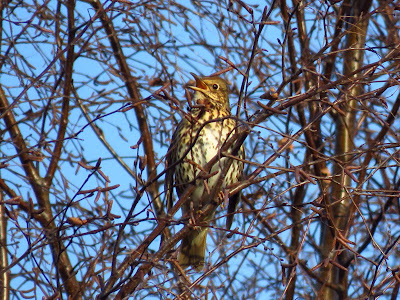
A long, 18 km walk to Castle Hill, a mound on the outskirts of Hull by Holderness Drain. It is sunny and the wind has eased, although there is frost and ice on the ground. The walk was mostly along pedestrian/cycle tracks, especially the Hornsea cycle lane.
As I cross Wilmington Bridge I check on the Redshank roost: 11 today, but I dond't have much time, as the bridge engineer tells me he's opening the bridge in a few minutes.
As I carry on, a 20 strong flock of small birds calls my attention. I follow them with the binoculars and they end up landing on a large buddleia bush, and appear to start feeding on the seed heads, something I've never seen before. They are in a patch of land covered in buddleias, one of the fastest colonisers of cleared up land. Later, on the way back, I come across the Linnets again, this time as they feed on a large mound of soil.
At Rockford fields there are quite a bit of Chaffinches, a male uttering it's broken early spring song. I hear the nasal call of a Brambling from a tall poplar, but despite some searching I can't find it and have to leave it at that.
I cut across the fields to join the Hornsea cycle track, also the TransPennine Way. The route has underpasses or bridges under some large roads, which is quite nice. The path is strait and by Sutton the landscape is more undulating, with steep banks covered on Ivy on the sides. Birds are plentiful.
As I step onto the first fields, I spot a Little Egret in the distance, glowing in the sunshine.
I get to Castle Hill just after crossing a bridge over Holderness Drain, which marks the Hull city boundary.













No comments:
Post a Comment